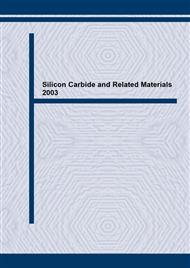[1]
J.P. Bergmann, H. Lendenmann, P.A. Nilsson, U. Lindenfelt and P. Skytt, Mater. Sci. Forum Vol. 353-356 (2001), p.299.
Google Scholar
[2]
R.E. Stahlbush, M. Fatemi, J.B. Fedison, S.D. Arthur, L.B. Rowland and S. Wang: J. Elec. Mat. Vol. 31 (2002), p.370.
Google Scholar
[3]
H. Lendenmann, F. Dahlquist, J.P. Bergmann, H. Bleichner and C. Hallin: Mater. Sci. Forum Vol. 389-393 (2002), p.1259.
DOI: 10.4028/www.scientific.net/msf.389-393.1259
Google Scholar
[4]
A. Galeckas, J. Linnros, and P. Pirouz, Appl. Phys. Lett. Vol. 81 (2002), p.883.
Google Scholar
[5]
M.E. Twigg, R.E. Stahlbush, M. Fatemi, S.D. Arthur, J.B. Fedison, J.B. Tucker and S. Wang: Appl. Phys. Lett. Vol. 82 (2003), p. (2010).
Google Scholar
[6]
M.S. Miao, S. Limpijumnong, W.R.L. Lambrecht: Appl. Phys. Lett. Vol. 79 (2001), p.4360.
Google Scholar
[7]
M. Skowronski, J.Q. Lui, W.M. Vetter, M. Dudley, C. Hallin, and H. Lendenmann, J. Appl. Phys. Vol. 92 (2002), p.4699.
Google Scholar
[8]
M.E. Twigg, R.E. Stahlbush, M. Fatemi, S.D. Arthur, J.B. Fedison, J.B. Tucker, and S. Wang, submitted to J. Elec. Mater. 100 µm 37 73 87 100 µm100 µm 37 73 87 Fig. 2. Expansion of parallelogram shaped stacking fault. The two fainter partial dislocations are different from the two brighter ones and the SF expands only by movement of the brighter partial dislocations.
DOI: 10.1007/s11664-004-0205-8
Google Scholar


